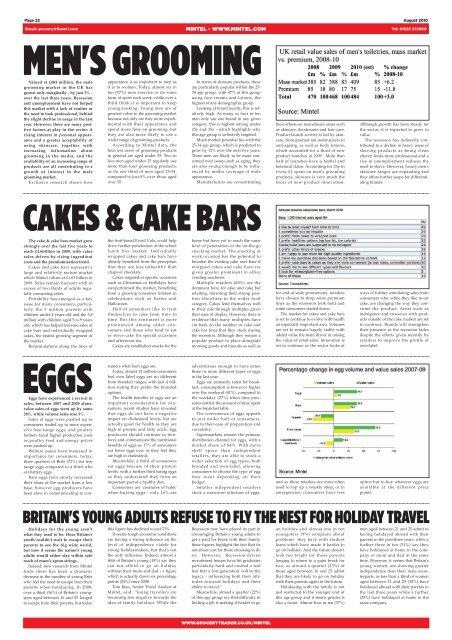grocery - food - Grandflame Ltd
grocery - food - Grandflame Ltd
grocery - food - Grandflame Ltd
Create successful ePaper yourself
Turn your PDF publications into a flip-book with our unique Google optimized e-Paper software.
Page 22 August 2010<br />
Email: <strong>grocery</strong>@flame1.com MINTEL - WWW.MINTEL.COM<br />
Tel: 01923 272960<br />
Valued at £484 million, the male<br />
grooming market in the UK has<br />
grown only marginally - by just 3% -<br />
over the last three years. Recession<br />
and unemployment have not helped<br />
this market with a lack of routine or<br />
the need to look professional, behind<br />
the slight decline in usage in the last<br />
year. However, there are many positive<br />
factors at play in the sector. A<br />
rising interest in personal appearance<br />
and a greater acceptability of<br />
using skincare, together with<br />
increasing information about<br />
grooming in the media, and the<br />
availability of an increasing range of<br />
products are all contributing to a<br />
growth of interest in the male<br />
grooming market.<br />
Exclusive research shows how<br />
MEN'S GROOMING<br />
appearance is as important to men as<br />
it is to women. Today, almost six in<br />
ten (57%) men exercise or do some<br />
form of sport each week, while over a<br />
third think it is important to keep<br />
young-looking. Young men are of<br />
greatest value to the grooming market<br />
because not only are they more experimental<br />
with their appearance and<br />
spend more time on grooming, but<br />
they are also more likely to use a<br />
wider range of grooming products.<br />
According to Mintel data, the<br />
heaviest users of grooming products<br />
in general are aged under 35. Two in<br />
five men aged under 25 regularly use<br />
more than four grooming products,<br />
as do one third of men aged 25-34,<br />
compared to just 8% over those aged<br />
over 55.<br />
In terms of skincare products, these<br />
are particularly popular within the 25-<br />
34 age group, with 47% of this group<br />
using face creams and lotions, the<br />
highest of any demographic group.<br />
Looking at brand loyalty, this is relatively<br />
high. As many as four in ten<br />
men only use one brand in any given<br />
category, this is highest among under<br />
25s and 35s - which highlights why<br />
this age group is so heavily targeted.<br />
Much market potential lies with the<br />
25-34 age group, which is predicted to<br />
grow by 12% over the next five years.<br />
These men are likely to be more concerned<br />
over issues such as aging, they<br />
are also young enough to be influenced<br />
by media coverage of male<br />
appearance.<br />
Manufacturers are concentrating<br />
their efforts on mainstream areas such<br />
as skincare, deodorants and hair care.<br />
Product launch activity is led by skincare,<br />
from gradual tan moisturizers to<br />
anti-ageing, as well as body lotions,<br />
which accounted for a third of new<br />
product launches in 2009. More than<br />
half of launches have a herbal and<br />
botanical claim. Accounting for 25p in<br />
every £1 spent on men's grooming<br />
products, skincare is very much the<br />
focus of new product innovation.<br />
Although growth has been steady for<br />
the sector, it is expected to grow in<br />
value.<br />
The recession has indirectly contributed<br />
to a decline in heavy users of<br />
shaving products as being clean<br />
shaven looks more professional and a<br />
rise in unemployment reduces the<br />
need to shave. However, luxury men's<br />
skincare ranges are expanding and<br />
they offers further scope for differentiating<br />
brands.<br />
CAKES & CAKE BARS<br />
The cake & cake bars market grew<br />
strongly over the last five years to<br />
reach £1.6billion in 2009, with value<br />
sales driven by rising ingredient<br />
costs and the premiumisation trend.<br />
Cakes and cake bars represent a<br />
large and relatively mature market<br />
which Mintel values at £1.63 billion in<br />
2009. Sales remain buoyant with in<br />
excess of two thirds of adults regularly<br />
consuming cakes.<br />
Portability has emerged as a key<br />
issue for many consumers, particularly<br />
the 3 million parents with<br />
children under 4-years-old and the 3.8<br />
million with children aged 5 to 9 years<br />
old, which has helped increase sales of<br />
cake bars and individually wrapped<br />
cakes, the fastest growing segment of<br />
the market.<br />
Reformulations along the lines of<br />
the fruit-based Evoid Cola, could help<br />
drive further penetration of the school<br />
lunch box market. Individually<br />
wrapped cakes and cake bars have<br />
already benefited from the perception<br />
that they are less unhealthy than<br />
crisps or chocolate.<br />
Cakes targeted at specific occasions<br />
such as Christmas or birthdays have<br />
out-performed the market, benefiting<br />
from a growing consumer interest in<br />
celebrations such as Easter and<br />
Halloween.<br />
Half of consumers like to treat<br />
themselves to cake from time to<br />
time. But this sentiment is more<br />
pronounced among older consumers<br />
and those who tend to eat<br />
or serve cake for special occasions<br />
and afternoon tea.<br />
Cakes are established snacks for the<br />
home but have yet to reach the same<br />
level of penetration in the on-the-go<br />
snacking market. The snacking at<br />
work occasion has the potential to<br />
broaden the existing cake user base if<br />
wrapped cakes and cake bars are<br />
given greater prominent in office<br />
vending machines.<br />
Multiple retailers (80%) are the<br />
dominant force for cake and cake bar<br />
retailing, mirroring their strong position<br />
elsewhere in the wider <strong>food</strong><br />
category. Cakes lend themselves well<br />
to their sale through multiples given<br />
their ease of display. However, there is<br />
evidence that many multiples have<br />
cut back on the number of cake and<br />
cake bar lines that they stock during<br />
the recession. Although they remain a<br />
popular product to place alongside<br />
morning goods and biscuits as well as<br />
for end-of-aisle promotions, retailers<br />
have chosen to drop some premium<br />
lines as the recession took hold and<br />
some consumers traded down.<br />
The market for cakes and cake bars<br />
is set to continue to evolve with health<br />
an especially important area. Volumes<br />
are set to remain largely stable with<br />
added value the main driver in raising<br />
the value of retail sales. Innovation is<br />
set to continue as the sector looks at<br />
ways of further stimulating sales from<br />
consumers who, while they like to eat<br />
cake, are changing the way they consume<br />
the product. Areas such as<br />
indulgence and crossover with products<br />
outside of the cake market are set<br />
to continue. Brands will strengthen<br />
their presence as the recession fades<br />
despite the efforts given recently by<br />
retailers to improve the profile of<br />
own-label.<br />
EGGS<br />
Eggs have experienced a revival in<br />
sales, between 2007 and 2009 alone,<br />
value sales of eggs went up by some<br />
28%, while volume sales rose 5%.<br />
Sales of eggs were pushed up as<br />
consumers traded up to more expensive<br />
free-range eggs, and poultry<br />
farmers faced higher production costs<br />
as poultry feed and energy prices<br />
were pushed up.<br />
Welfare issues have increased in<br />
importance for consumers, today,<br />
three quarters of Brits (73%) eat free<br />
range eggs compared to a third who<br />
eat battery eggs.<br />
Barn eggs have slowly increased<br />
their share of the market from a low<br />
base; however egg producers have<br />
been slow in communicating to consumers<br />
what barn eggs are.<br />
Today, almost 12 million consumers<br />
feel own label eggs are no different<br />
from branded ranges, with just 4 million<br />
stating they prefer the branded<br />
options.<br />
The health benefits of eggs are an<br />
important consideration for consumers,<br />
recent studies have revealed<br />
that eggs do not have a negative<br />
impact on cholesterol levels, but are<br />
actually good for health as they are<br />
high in protein and fatty acids. Egg<br />
producers should continue to reinforce<br />
and communicate the nutritional<br />
benefits of eggs as 17% of consumers<br />
eat fewer eggs now as they feel they<br />
are high in cholesterol.<br />
Meanwhile, a third of consumers<br />
eat eggs because of their protein<br />
levels, with a further third eating eggs<br />
as they understand they form an<br />
important part of a healthy diet.<br />
Consumers are 'creatures of habit'<br />
when buying eggs - only 16% are<br />
adventurous enough to have eaten<br />
three or more different types of eggs<br />
in the last year.<br />
Eggs are primarily eaten for breakfast;<br />
consumption is however higher<br />
over the weekend (41%), compared to<br />
the weekday (27%) when time pressures<br />
restrict the amount of time spent<br />
at the breakfast table.<br />
The convenience of eggs appeals<br />
to just under half of consumers,<br />
due to their ease of preparation and<br />
versatility.<br />
Supermarkets remain the primary<br />
distribution channel for eggs, with a<br />
market share of 84%. With more<br />
shelf space than independent<br />
retailers, they are able to stock a<br />
wider selection of egg types, both<br />
branded and own-label, allowing<br />
consumers to choose the type of egg<br />
they want depending on their<br />
budget.<br />
Smaller independent retailers<br />
stock a narrower selection of eggs,<br />
and as these retailers are more often<br />
used to top up a weekly shop, or in<br />
emergencies, consumers have less<br />
option but to buy whatever eggs are<br />
available at the different price<br />
points.<br />
BRITAIN'S YOUNG ADULTS REFUSE TO FLY THE NEST FOR HOLIDAY TRAVEL<br />
Holidays for the young aren't<br />
what they used to be. Once Britain's<br />
youth couldn't wait to escape their<br />
parents to see the big wide world,<br />
but now it seems the nation's young<br />
adults would rather stay within safe<br />
reach of mum's apron strings.<br />
Indeed, new research from Mintel<br />
finds there has been a dramatic<br />
decrease in the number of young Brits<br />
who feel the need to escape from their<br />
parents when holidaying. In 2008,<br />
over a third (36%) of Britain's youngsters<br />
aged between 16 and 25 longed<br />
to escape from their parents, but today<br />
this figure has declined to just 23%.<br />
It seems tough economic conditions<br />
are having a strong influence on the<br />
level of independence viable for<br />
young holidaymakers, but that's not<br />
the only influence. Indeed, almost a<br />
fifth of Britain's young (18%) say they<br />
can not afford to go on holiday<br />
without their mum and dad - a figure<br />
which is actually down six percentage<br />
points (24%) since 2008.<br />
Tom Rees, Senior Travel Analyst at<br />
Mintel, said: "Young travellers are<br />
becoming less negative towards the<br />
idea of family holidays. While the<br />
Recession may have played its part in<br />
encouraging Britain's young adults to<br />
get a paid for break with their family,<br />
these figures highlight the fact that its<br />
not about cost for those choosing to do<br />
so. However, Recession-driven<br />
recruitment freezes have hit graduates<br />
particularly hard and created a real<br />
fear that a 'lost generation' will be the<br />
legacy - influencing both their attitudes<br />
towards holidays and their<br />
ability to travel.”<br />
Meanwhile, almost a quarter (22%)<br />
of this age group say that difficulty in<br />
finding a job is making it harder to go<br />
on holiday and almost one in ten<br />
youngsters (9%) complain about<br />
problems they have with student<br />
loans which have made it harder to<br />
go on holiday. And the future doesn't<br />
look too bright for those parents<br />
longing to return to a quiet break for<br />
two, as around a quarter (23%) of<br />
those aged between 16 and 25 admit<br />
that they are likely to go on holiday<br />
with their parents again in the future.<br />
Holidaying with the family is not<br />
just restricted to the younger end of<br />
this age group and it seems gender is<br />
also a factor. Almost four in ten (37%)<br />
men aged between 21 and 25 admit to<br />
having holidayed abroad with their<br />
parents in the past three years, while a<br />
further three in ten (31%) say they<br />
have holidayed at home in the company<br />
of mum and dad in the same<br />
time. However, it seems that Britain's<br />
young women, are showing greater<br />
independence than their male counterparts,<br />
as less than a third of women<br />
aged between 21 and 25 (32%) have<br />
holidayed abroad with their parents in<br />
the last three years while a further<br />
(25%) have holidayed at home in the<br />
same company.<br />
WWW.GROCERYTRADER.CO.UK/MINTEL














